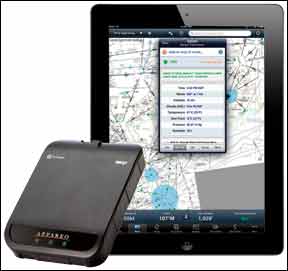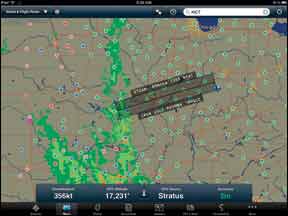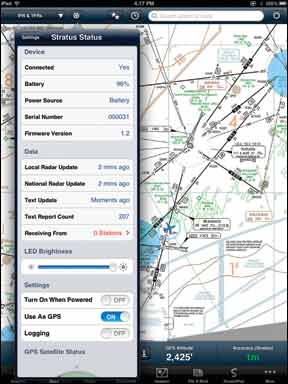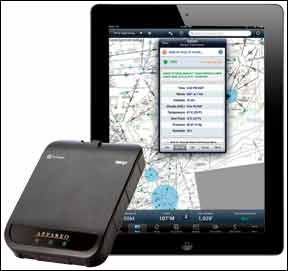In-flight weather for the iPad is nothing new. SkyRadar’s ADS-B receiver worked with WingX for we’ll over a year, and Baron’s Mobile Link can deliver XM satellite weather to ForeFlight, Global Nav Source, FlightGuide and others.

What is new is some competition. Sporty’s Pilot Shop teamed up with ForeFlight and device manufacturer Appareo to offer ADS-B weather on an iPad with the $799 Stratus. Not only has the $799 Stratus’ appearance forced a price-drop on competing units, it’s also set a new bar for simplicity. Stratus requires no power cords or external antennas for an average flight. The box has all of one button. Turn it on. Go fly.
Seamless Integration
Stratus is a WiFi basestation, so you connect your iPad to the Stratus the same way you connect to the FBO internet. Once your iPad has memorized the network, it will connect automatically. If you’re an über-geek, you can even connect several iOS devices at once, and run ForeFlight with ADS-B weather on all of them. Stratus has an internal GPS and can act as the GPS source for ForeFlight in addition to supplying weather.
ForeFlight treats weather data from Stratus basically the same way it treats data from the internet. METARs, TAFs, winds aloft and NOTAMs are in the airport information pages. PIREPs, AIRMET/SIGMETs and TFRs appear positioned on the map. Tap them and you’ll get a pop-up window with details. ADS-B NEXRAD replaces the internet NEXRAD.
So, if you know how to use ForeFlight’s weather on the ground, your learning curve for using Stratus is about as steep as central Kansas.
Not Quite Satellite
There are some operational differences between ADS-B weather and what you’d get from the internet or XM, however. You won’t see storm tops or movement. The radar is not animated and is lower fidelity than ForeFlight’s internet NEXRAD.
Actually, ADS-B NEXRAD comes in two flavors: high-res and low-res. There’s a low-res image for the entire CONUS. (Alaska also has its own ADS-B network, but Stratus will work there, too.) You also get a high-res image for roughly 250 miles around your position. ForeFlight mixes these images into a composite picture (you can see both resolutions in the image on page 16). The local image has five times the refresh rate of the CONUS one, so it can seem a bit out of sync with fast-moving storms, and you only get a general picture of what’s going on 400 miles away.

In practice, this radar is ample in detail and refresh speed for tactical decisions. We found the display worked fine even on our iPad 1 with partial transparency. A cool plus of something like ForeFlight is overlaying NEXRAD directly on an en route or sectional chart.
For the record, all the ADS-B data except CONUS NEXRAD is limited radius. Most often you won’t get weather more than 500 miles from your current position. It’s important to note the source and age of weather data. For instance, a METAR’s age appears in green if it’s recent, turning amber and red as it gets more out of date. If it’s ADS-B-derived weather, it says in parentheses.
You can also see the general age of your weather information at all times on the top left of the map. It’s white for recent data, turning amber and red as it ages. It says “Stratus” in parentheses when the iPad is connected to the Stratus.
For exhaustive detail, there’s a pull-down menu showing you all the Stratus stats, including battery life, GPS satellites in view and the error rate for all ADS-B ground stations. This pull-down is also home for general NOTAMs for your area, but not associated with an airport. It’s not an obvious place for them, but they’re available if you want them.
ForeFlight can display lightning and satellite imagery, but these products aren’t included in ADS-B, so nothing appears on the map. Make sure you have the latest update to ForeFlight, because without it there’s no warning that the dearth of lightning is “no data” rather than “no lightning.” Missing radar data is obvious, as the map shows hash marks over all areas where recent radar is missing.

Future development is factor, too, when looking at ADS-B weather. XM weather products continue to evolve; ADS-B is from the FAA. What you see is what you’re going to get for a long time.
Speaking of Reception
One universal weakness with all ADS-B weather systems is that, with a few exceptions, you can’t receive it on the ground. Much of the U.S. has coverage from about 1500 feet AGL upward, but pilots in mountainous regions, however, may have to travel high and far before they get line-of-sight to an ADS-B ground station.
Where we tested Stratus in Portland, Maine, we normally get ADS-B data climbing through 700 feet, but the unit we had repeatedly lost all contact even at 3000 feet. This is such bad reception, that we suspected a hardware problem.
Sporty’s couldn’t get us a replacement—Stratus is already backordered with surging sales—so they sent us the optional $60 external antenna. The problem vanished like magic, with reception matching or exceeding the SkyRadar ADS-B box we’ve flown with in the past. Experimentation in three different airplanes showed the Stratus only misbehaved on the glareshield above the avionics, receiving fine from the backseat.
Given that this was a pre-production unit and we can’t find another instance of this despite all the Stratus units flying, we’re confident this is an anomaly—a bad box—and most people shouldn’t need the external antenna. We did find comments from some people about Stratus units getting too hot up on glareshields and displaying a warning. Be aware the external antenna is ADS-B only. There’s no remote antenna for GPS, but using Stratus’ internal GPS isn’t required.
The Leading Edge
Is Stratus the must-have gadget for 2012? We wouldn’t go that far. We’re going out a limb and saying this will be the summer of portable ADS-B.
SkyRadar was the only other option, and their prices dropped to $679 when Stratus hit the market. SkyRadar also has the potential for connecting a Zaon traffic system for traffic alerting. FreeFlight Systems has an in-panel solution that will meet the ADS-B mandate and will have a wireless connection for both weather and traffic. We asked Zimmerman of Sporty’s if Stratus had latent capability to patch traffic or connect to other systems. He said this box didn’t, but future systems certainly might.
All that said, the biggest decider might be what app you like to use. ForeFlight is the weapon of choice for a majority of iPad pilots, and Stratus is the only ADS-B weather option for now. Given that its only limitations are really the limitations of the ADS-B system in general, we expect Stratus units will rightly remain a top seller for months to come.


